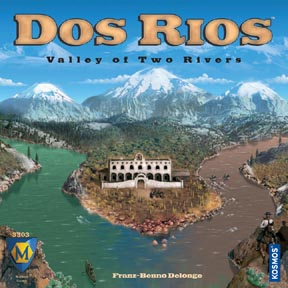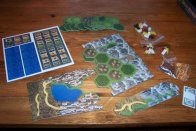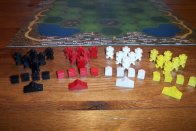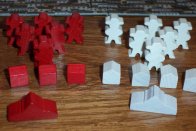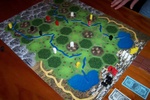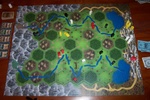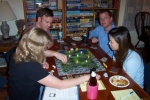
|
Dos Rios A game by Franz-Benno Delonge Published by Mayfair Games, Inc. and Kosmos Players: 2 to 4 Time: 60-90 minutes Reviewed by Susan Rozmiarek |

|
When I first heard about this new game by Frank-Benno Delonge, my interest was immediately piqued. This designer only has a small handful of published designs (that I know of), but they vary widely in type. Because they include two of our light family favorites, Big City and TransAmerica, I was very interested to see what he had come up with next.
Components:
These are of excellent quality and up to the usual high standards one has come to expect from games manufactured in Germany.
The board and tiles are of medium thickness and fairly sturdy.
- Board: This consists of 6 edge pieces and 12 land tiles that fit together like a puzzle, allowing for a random setup each game. The board, when put together, consists of hexes that depict different land types.
- 40 River tiles
- 15 harvest cards
- 40 wooden sticks representing dams
- 4 sets of wooden pieces in individual player colors, with each set including 6 campesinos (people), 4 casas (small building) and one hacienda (large building).
- Play money
- Rules: The rules are only four pages long with numerous color illustrations. They are easy to understand and we found no ambiguities.
Game play:
The goal of the game is to be the first player to build all (or most) of one's buildings. To do this, players will be raising money by moving their campesinos out into the valley and harvesting crops. Two rivers run down from the mountains and through the valley with only the fertile regions along the river routes producing crops. With timely placements of their campesinos and the help of dams to change the rivers' courses, players will earn the necessary cash to build their hacienda and casas. Unfortunately, fierce desperadoes and competition from other players can foil the best-made plans.
After randomly laying out the board, a starting player is chosen. The starting player lays out the two rivers from the springs in the mountains at the top of the board to the lakes and/or city at the bottom. He does this on a hex-by-hex basis using the following placement rules:
- The river course must always flow downward from the mountains at the top of the board to the lake at the bottom. Thus, there are three possible hexes the river can flow to from a given hex.
- Of these three possible hexes, he must choose the one that is the lowest, based on terrain type. Mountains are the highest, followed by forests, and followed by plains. The lakes and the city at the southern edge of the board are the very lowest regions.
- If there are two or more hexes of the same type that are the lowest, the player may choose between them.
A player's turn consists of two phases. The first phase consists of moving campesinos and building dams and buildings. The second phase is harvesting. A more in-depth description of the phases follows:
-
Moving campesinos and building:
These actions may be done in any order. A player has six action points in which to move his campesinos on his turn. Moving a campesino to an adjacent hex costs one action point. There are also wagon trails on the edges of the board leading partway up the valley with several exits to choose from that allow for cheaper movement. In addition, campesinos can teleport from the city to their hacienda for two action points. A maximum of two campesinos and only ones of the same color can occupy each hex. All enemy campesinos must be frightened away. This is either accomplished by outnumbering the enemy or by moving in from a hex of a higher terrain type. Frightened campesinos run back to the city in terror.
If a player has a campesino on a hex, he may build a casa or hacienda there, for a cost of 500 or 1000 Rios, respectably. However, a player may never build more than two buildings on a single turn and a hex may only have one building. So, secretly saving up cash and swooping in for a surprise victory is not always easy with experienced players, who will almost certainly be watching those close to winning.
A player may also build a dam on an edge of a hex on which he has a campesino, provided that he has a dam in his possession. He does not have to block the river. Indeed, building a dam is often a preventative measure to keep the river from ever flowing a certain way. If the dam placement does block the river, the player now reroutes the river following the same rules as in the initial setup. However, there must always be a route for the river out of any hex, therefore all three possible hexes cannot be blocked. If the river rejoins its former course, it will continue the rest of the way as before. It is possible for the two rivers to merge.
Harvest Phase:
There are a 15 harvest cards in the game that depict either a type of region to be harvested
(wheat, corn, tobacco or forest), one of the rivers, or desperadoes (more about them later).
A number of these cards equal to the number of players plus one, are flipped up to form
a row at the beginning of the game.
The player can choose to resolve the current harvest card, which is always the one furthest
in the row from the draw pile, or not.
If he chooses not to, the card is simply moved to the back of the queue.
If he does decide to harvest, all hex of this type that have a river running through them are harvested.
Each one occupied by a campesino or building earns its owner 100 Rios.
The exceptions are the forest tiles.
These do not earn money but rather a dam "stick."
If the harvest card depicts a river rather than a type of crop, then all hexes
through which that river flows are harvested.
After harvesting, another harvest card is drawn from the deck and added to the back of the row.
In this way, a player can always look ahead and see what is possibly going to be harvested, including on his next turn.
There are also two desperado cards in the deck, one for each river. These are resolved immediately when drawn. Desperadoes come down out of the mountains from the north and travel along that particular river, terrorizing campesinos and scaring them back to the city. They scare the first three campesinos they meet on the river's route with a maximum of one per region. They will skip haciendas, however, and any campesinos on the hex with their hacienda are safe.
Comments:
The river route mechanism is simply ingenious and provides many more possibilities for clever positioning. I've seen games won by a player getting his fourth building built in the open and then cleverly rerouting the river through that region. Players really have to be sharp to see the tactical possibilities in this game.
That said, there are a few strategic opportunities in this game, although they are subtle. Haciendas can be built higher up in the valley near fertile regions so that campesinos can be gotten to those areas quickly and cheaply. Also, these regions are more likely to be attacked by desperadoes against which the hacienda protects. Buildings in general can be built on hexes that are likely to retain the river through them, so that they always pay out when harvested. Likewise, dams can be built to further ensure this.
The downside to a game of this type is, of course, the potential for the game to drag from analysis paralysis. The board can change drastically between turns, so a player can't always do much planning until it is his turn. I am not bothered by this nearly as much as some people and enjoy watching what other players do on their turn. Most of the people I play with are able to make their decisions quickly enough to keep the game moving. However, some are very bothered by this and may find Dos Rios not to their tastes because of it. I have a hunch that this will be mitigated some by playing with fewer players. However, all my games have been with a full contingency of four, so I can't comment on how it plays with fewer.
Summary:
Dos Rios is an excellent offering by designer Frank-Benno Delonge for lovers of tactical,
puzzle-like games of timing and position.
With plenty of interaction between players on the board and the opportunities for clever moves,
I found the game to be very enjoyable as did the others in my game group.
The potential for downtime between turns will be an issue for some, however,
as will the dominance of tactical strategy over long-term strategy.
If you do enjoy this kind of game though, Dos Rios fits the bill superbly.
With fairly simple rules that fit theme nicely, it is easy to teach to beginners yet has
enough depth to explore for more serious gamers.
Given these features and the replay value of the variable board,
I expect Dos Rios to see quite a bit of table-time in both our family and our game group.
| Other Web information: |
This page viewed
E-mail Ed Rozmiarek with questions or problems concerning this page.
Copyright © 2004, Ed & Susan Rozmiarek
